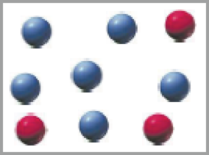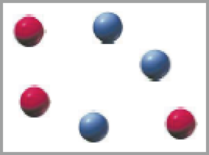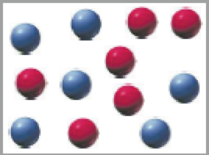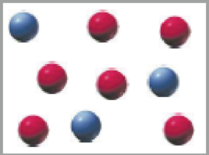
The following reaction is first order in A (red spheres) and first order in B (blue spheres):




- (a) What are the relative
rates of this reaction in vessels (1)–(4)? Each vessel has the same volume. - (b) What are the relative values of the rate constant k for cases (1)–(4)?
(a)
Interpretation:
The relative rates of the reaction in the given vessels has to be given.
Concept introduction:
Rate of reaction:
The rate of a reaction is defined by the change in concentration of substrate (reactant) or target (product) with change in time.
Answer to Problem 12.24CP
The relative rates of the reaction in the given vessels (1) – (4) are
Explanation of Solution
Given reaction and information,

Figure 1
Given as
Hence, the rate of reaction is proportional to the product of the number of
In the vessel (1), the product of
In the vessel (2), the product of
In the vessel (3), the product of
In the vessel (4), the product of
Therefore, the relative rates of the reaction in the given vessels (1) – (4) are
(b)
Interpretation:
The relative values of rate constants of the given reaction has to be given.
Concept introduction:
Rate law:
It is an equation that related to the dependence of the reaction rate on the concentration of each substrates (reactants).
Answer to Problem 12.24CP
- The relative values of rate constant for all the given reactions are same.
Explanation of Solution
Given reaction and information,

Figure 1
Given as
Hence, the rate of reaction is proportional to the product of the number of
The relative of the reaction in vessels (1) – (4) are
The relative value of rate constant for all the given reactions are same. Since, the same reaction takes place in each of the given vessels (1) – (4).
Want to see more full solutions like this?
Chapter 12 Solutions
General Chemistry: Atoms First
- For the condensation reaction between Alamine and histamine, please help me write the amididation reaction mechanism. Then write the three letter code for the product of the reaction, then write the one letter code for the product of the reaction. arrow_forwardHow to draw the reaction mechasnism belowarrow_forwardName the following molecules with IUpacarrow_forward
- What is the molecular orbital for cyclopropenyl anion and is it aromatic, antiaromatic or nonaromatic?arrow_forwardUsing the chart describe the change from cystine to tyrosine and its impact on the protein. Using the chart describe the change from histidine to aspartic acid and its impact on the protein.arrow_forwardHow to get the predicted product of this reaction belowarrow_forward
- Please help me fill out the chart then using the chart describe the change from cystine to tyrosine and its impact on the protein. Then using the chart describe the change from histidine to aspartic acid.arrow_forwardWrite the Esterification reaction mechanism for acetic acid, and one propanol to make propanol ethanoate (molecule that gives peas its odor in flavor)arrow_forwardProvide solutionsarrow_forward
 ChemistryChemistryISBN:9781305957404Author:Steven S. Zumdahl, Susan A. Zumdahl, Donald J. DeCostePublisher:Cengage Learning
ChemistryChemistryISBN:9781305957404Author:Steven S. Zumdahl, Susan A. Zumdahl, Donald J. DeCostePublisher:Cengage Learning Chemistry: An Atoms First ApproachChemistryISBN:9781305079243Author:Steven S. Zumdahl, Susan A. ZumdahlPublisher:Cengage Learning
Chemistry: An Atoms First ApproachChemistryISBN:9781305079243Author:Steven S. Zumdahl, Susan A. ZumdahlPublisher:Cengage Learning
 Chemistry: Principles and PracticeChemistryISBN:9780534420123Author:Daniel L. Reger, Scott R. Goode, David W. Ball, Edward MercerPublisher:Cengage Learning
Chemistry: Principles and PracticeChemistryISBN:9780534420123Author:Daniel L. Reger, Scott R. Goode, David W. Ball, Edward MercerPublisher:Cengage Learning Chemistry: The Molecular ScienceChemistryISBN:9781285199047Author:John W. Moore, Conrad L. StanitskiPublisher:Cengage Learning
Chemistry: The Molecular ScienceChemistryISBN:9781285199047Author:John W. Moore, Conrad L. StanitskiPublisher:Cengage Learning Chemistry & Chemical ReactivityChemistryISBN:9781337399074Author:John C. Kotz, Paul M. Treichel, John Townsend, David TreichelPublisher:Cengage Learning
Chemistry & Chemical ReactivityChemistryISBN:9781337399074Author:John C. Kotz, Paul M. Treichel, John Townsend, David TreichelPublisher:Cengage Learning





